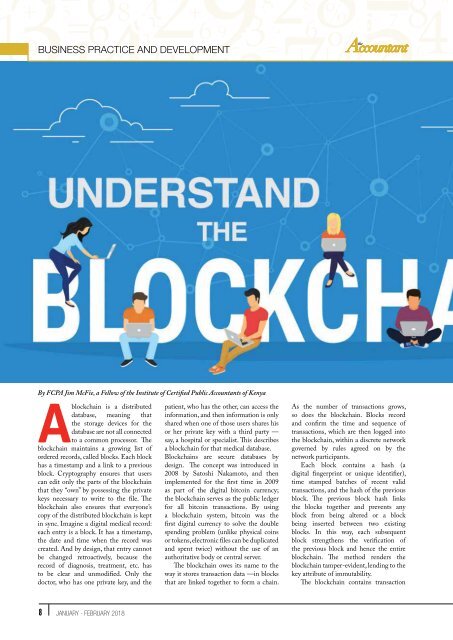The-Accountant-Jan-Feb-2018
You also want an ePaper? Increase the reach of your titles
YUMPU automatically turns print PDFs into web optimized ePapers that Google loves.
Information BUSINESS PRACTICE Technology AND DEVELOPMENT<br />
By FCPA Jim McFie, a Fellow of the Institute of Certified Public <strong>Accountant</strong>s of Kenya<br />
A<br />
blockchain is a distributed<br />
database, meaning that<br />
the storage devices for the<br />
database are not all connected<br />
to a common processor. <strong>The</strong><br />
blockchain maintains a growing list of<br />
ordered records, called blocks. Each block<br />
has a timestamp and a link to a previous<br />
block. Cryptography ensures that users<br />
can edit only the parts of the blockchain<br />
that they “own” by possessing the private<br />
keys necessary to write to the file. <strong>The</strong><br />
blockchain also ensures that everyone’s<br />
copy of the distributed blockchain is kept<br />
in sync. Imagine a digital medical record:<br />
each entry is a block. It has a timestamp,<br />
the date and time when the record was<br />
created. And by design, that entry cannot<br />
be changed retroactively, because the<br />
record of diagnosis, treatment, etc. has<br />
to be clear and unmodified. Only the<br />
doctor, who has one private key, and the<br />
patient, who has the other, can access the<br />
information, and then information is only<br />
shared when one of those users shares his<br />
or her private key with a third party —<br />
say, a hospital or specialist. This describes<br />
a blockchain for that medical database.<br />
Blockchains are secure databases by<br />
design. <strong>The</strong> concept was introduced in<br />
2008 by Satoshi Nakamoto, and then<br />
implemented for the first time in 2009<br />
as part of the digital bitcoin currency;<br />
the blockchain serves as the public ledger<br />
for all bitcoin transactions. By using<br />
a blockchain system, bitcoin was the<br />
first digital currency to solve the double<br />
spending problem (unlike physical coins<br />
or tokens, electronic files can be duplicated<br />
and spent twice) without the use of an<br />
authoritative body or central server.<br />
<strong>The</strong> blockchain owes its name to the<br />
way it stores transaction data —in blocks<br />
that are linked together to form a chain.<br />
As the number of transactions grows,<br />
so does the blockchain. Blocks record<br />
and confirm the time and sequence of<br />
transactions, which are then logged into<br />
the blockchain, within a discrete network<br />
governed by rules agreed on by the<br />
network participants.<br />
Each block contains a hash (a<br />
digital fingerprint or unique identifier),<br />
time stamped batches of recent valid<br />
transactions, and the hash of the previous<br />
block. <strong>The</strong> previous block hash links<br />
the blocks together and prevents any<br />
block from being altered or a block<br />
being inserted between two existing<br />
blocks. In this way, each subsequent<br />
block strengthens the verification of<br />
the previous block and hence the entire<br />
blockchain. <strong>The</strong> method renders the<br />
blockchain tamper-evident, lending to the<br />
key attribute of immutability.<br />
<strong>The</strong> blockchain contains transaction<br />
8 JANUARY - FEBRUARY <strong>2018</strong>

















